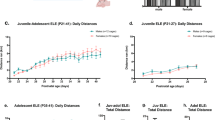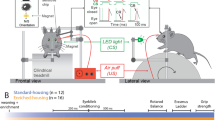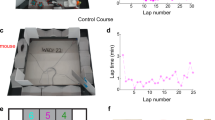Abstract
Exposure to an enriched environment increases neurogenesis in the dentate gyrus of adult rodents. Environmental enrichment, however, typically consists of many components, such as expanded learning opportunities, increased social interaction, more physical activity and larger housing. We attempted to separate components by assigning adult mice to various conditions: water-maze learning (learner), swim-time-yoked control (swimmer), voluntary wheel running (runner), and enriched (enriched) and standard housing (control) groups. Neither maze training nor yoked swimming had any effect on bromodeoxyuridine (BrdU)-positive cell number. However, running doubled the number of surviving newborn cells, in amounts similar to enrichment conditions. Our findings demonstrate that voluntary exercise is sufficient for enhanced neurogenesis in the adult mouse dentate gyrus.
This is a preview of subscription content, access via your institution
Access options
Subscribe to this journal
Receive 12 print issues and online access
$209.00 per year
only $17.42 per issue
Buy this article
- Purchase on Springer Link
- Instant access to full article PDF
Prices may be subject to local taxes which are calculated during checkout




Similar content being viewed by others
References
Rasool, C. G., Svendsen, C. & Selkoe, D. J. Neurofibrillary degeneration of cholinergic and non-cholinergic neurons of the basal forebrain in Alzheimer's disease. Ann. Neurol. 20, 482–488 ( 1986).
Uhl, G. R., Hedreen, J. C. & Price, D. L. Parkinson's disease: Loss of neurons from the ventral tegmental area contralateral to therapeutic surgical lesions. Neurology 35, 1215–1218 (1985).
Adams, R. D. & Victor, M. Principles of Neurology (McGraw-Hill, New York, 1991).
Altman, J. & Das, G. D. Autoradiographic and histological evidence of postnatal neurogenesis in rats. J. Comp. Neurol. 124, 319–335 (1965).
Kuhn, H. G., Dickinson-Anson, H. & Gage, F. H. Neurogenesis in the dentate gyrus of the adult rat: age-related decrease of neuronal progenitor proliferation. J. Neurosci. 16, 2027–2033 ( 1996).
Kempermann, G., Kuhn, H. G. & Gage, F. H. More hippocampal neurons in adult mice living in an enriched environment. Nature 386, 493– 495 (1997).
Kempermann, G., Kuhn, H. G. & Gage, F. H. Genetic influence in the dentate gyrus of mice. Proc. Natl. Acad. Sci. USA 94, 10409– 10414 (1997).
Lois, C. & Alvarez-Buylla, A. Proliferating subventricular zone cells in the adult mammalian forebrain can differentiate into neurons and glia. Proc. Natl. Acad. Sci. USA 90, 2074–2077 (1993).
Gould, E., Tanapat, P., McEwen, B. S., Flugge, G. & Fuchs, E. Proliferation of granule cell precursors in the dentate gyrus of adult monkeys is diminished by stress. Proc. Natl. Acad. Sci. USA 95, 3168– 3171 (1998).
Eriksson, P. S. et al. Neurogenesis in the adult human hippocampus. Nat. Med. 4, 1313–1317 ( 1998).
Rosenzweig, M. R., Krech, D., Bennett, E. L. & Diamond, M. C. Effects of environmental complexity and training on brain chemistry and anatomy. J. Comp. Physiol. Psychol. 55, 429– 437 (1962).
Greenough, W. T. Experiential modification of the developing brain. Am. Sci. 63, 37–46 (1975).
Juraska, J. M., Fitch, J., Henderson, C. & Rivers, N. Sex differences in the dendritic branching of dentate granule cells following differential experience. Brain Res. 333, 73– 80 (1985).
Juraska, J. M., Fitch, J. & Washburne, D. L. The dendritic morphology of pyramidal neurons in the rat hippocampal CA3 area II. Effects of gender and experience. Brain Res. 479, 115–119 (1989).
Rosenzweig, M. R., Bennett, E. L., Herbert, M. & Morimoto, H. Social grouping cannot account for cerebral effects of enriched environments. Brain Res. 153, 563–576 (1978).
Kempermann, G., Kuhn, H. G. & Gage, F. H. Experience-induced neurogenesis in the senescent dentate gyrus. J. Neurosci. 18, 3206– 3212 (1998).
Kempermann, G., Brandon, E. P. & Gage, F. H. Environmental stimulation of 129/SvJ mice causes increased cell proliferation and neurogenesis in the adult dentate gyrus. Curr. Biol. 8, 939–942 (1998).
Bennett, E. L., Rosenzweig, M. R., Morimoto, H. & Herbert, M. Maze training alters brain weights and cortical RNA/DNA ratios. Behav. Neural. Biol. 26, 1–22 (1979).
Barnea, A. & Nottebohm, F. Seasonal recruitment of hippocampal neurons in adult free-ranging black-capped chickadees. Proc. Natl. Acad. Sci. USA 91, 11217–11221 (1994).
Barnea, A. & Nottebohm, F. Recruitment and replacement of hippocampal neurons in young and adult chickadees: An addition to the theory of hippocampal learning. Proc. Natl. Acad. Sci. USA 93, 714–718 (1996).
Patel S. H., Clayton, N. S. & Krebs, J. R. Spatial learning induces neurogenesis in the avian brain. Behav. Brain Res. 89, 115– 128 (1998).
Johansson, B. B. & Ohlsson, A. Environment, social interaction and physical activity as determinants of functional outcome after cerebral activity in the rat. Exp. Neurol. 139, 322–327 (1997).
Fordyce, D. E. & Wehner, J. M. Physical activity enhances spatial learning performance with an associated alteration in hippocampal protein kinase C activity in C57BL/6 and DBA/2 mice. Brain Res. 619, 111–119 ( 1993).
Blomquist, K. B. & Danner F. Effect of physical conditioning on information-processing efficiency. Percept. Motor Skills 65, 175–186 ( 1987).
Neeper, S. A., Gomez-Pinilla F., Choi, J. & Cotman, C. Exercise and brain neurotrophins. Nature 373, 109 (1995).
Gensburger, C., Labourdette, G. & Sensenbrenner, M. Brain basic fibroblast growth fator stimulates the proliferation of rat neuronal precursor cells in vitro. FEBS Lett. 217, 1–5 (1987).
Ray, J., Peterson, D. A., Schinstine, M. & Gage, F. H. Proliferation, differentiation, and long-term culture of primary hippocampal neurons. Proc. Natl. Acad. Sci. USA 90, 3602–3606 (1993).
Tao, Y., Black, I. B. & DiCicco-Bloom, E. Neurogenesis in neonatal rat brain is regulated by peripheral injection of basic fibroblast growth factor (bFGF). J. Comp. Neurol. 376, 653–663 ( 1996).
Kuhn, H. G, Winkler, J., Kempermann, G., Thal, L. J. & Gage, F. H. Epidermal growth factor and fibroblast growth factor-2 have different effects on neural progenitors in the adult rat brain. J. Neurosci. 17, 5820– 5829 (1997).
Gomez-Pinilla, F., Dao, L. & Vannarith, S. Physical exercise induces FGF-2 and its mRNA in the hippocampus. Brain Res. 764, 1– 8 (1997).
Gomez-Pinilla, F., So, V. & Kesslak, J. P. Spatial learning and physical activity contribute to the induction of fibroblast growth factor: neural substrates for increased cognition associated with exercise. Neuroscience 85, 53–61 (1998).
Mullen, R. J., Buck, C. R. & Smith, A. M. NeuN, a neuronal specific nuclear protein in vertebrates. Development 116, 201–211 (1992).
Boyes, B. E., Kim, S. U., Lee, V. & Sung, S. C. Immunohistochemical colocalization of S100b and the glial fibrillary acidic protein in rat brain. Neuroscience 17, 857–865 (1986).
Morris, R. G. M. Development of a water maze procedure for studying spatial learning in the rat. J. Neurosci. Methods 11, 47– 60 (1984).
Palmer, T., Takahashi, J. & Gage, F. H. The adult rat hippocampus contains primordial neural stem cells. Mol. Cell. Neurosci. 8, 389– 404 (1997).
Park, G. A., Pappas, B. A., Murtha, S. M. & Ally, A. Enriched environment primes forebrain choline acetyltransfrease activity to respond to learning experience. Neurosci. Lett. 143 , 259–262 (1992).
Dudar, J. D., Wishaw, I. Q. & Szerb, J. C. Release of acetylcholine from the hippocampus of freely moving rats during sensory stimulation and running. Neuropharmacology 18, 673–678 ( 1979).
Falkenberg, T. et al. Increased expression of brain-derived neurotrophic factor mRNA in rat hippocampus is associated with improved spatial memory and enriched environment. Neurosci. Lett. 138, 153– 156 (1992).
Nowakowski, R. S., Lewin, S. B. & Miller, M. W. Bromodeoxyuridine immunohistochemical determination of the lengths of cell cycle and the DNA-synthetic phase for an anatomically defined population. J. Neurocytol. 18, 311 –318 (1989).
Czurko, A., Hirase, H., Csicsvari, J. & Buzsáki, G. Sustained activation of hippocampal pyramidal cells by 'space clamping' in a running wheel. Eur. J. Neurosci. 11, 344 –352 (1999).
Valentinuzzi, V. S., Scarbrough, K., Takahashi, J. S. & Turek, F. W. Effects of aging on the circadian rhythm of wheel-running activity in C57BL/6 mice. Am. J. Physiol. 273, R1957– 1964 (1997).
Staubli, U. & Xu, F. B. Effects of 5-HT3 receptor antagonism on hippocampal theta rhythm, memory and LTP induction in the freely moving rat. J. Neurosci. 15, 2445– 2452 (1995).
van Praag, H., Black, I. B. & Staubli, U. V. Neonatal vs. adult unilateral hippocampal lesions: differential alterations in contralateral hippocampal theta rhythm. Brain Res. 768, 233–241 (1997).
Gould, E. & Cameron, H. A. Regulation of neuronal birth, migration and death in the rat dentate gyrus. Dev. Neurosci. 18, 22–35 (1996).
Gould, E., Beylin A., Tanapat, P., Reeves, A. J. & Shors, T. J. Learning enhances adult neurogenesis in the hippocampal formation. Nat. Neurosci. 2, 260–265 (1999).
Morris, R. G. M., Andersen, E., Lynch, G. S. & Baudry, M. Selective impairment of learning and blockade of long-term potentiation by an N-methyl-D-aspartate antagonist, APV. Nature 319 , 774–776 (1986).
Cameron, H. A., McEwen, B. S. & Gould, E. Regulation of adult neurogenesis by excitatory input and NMDA receptor activation in the dentate gyrus. J. Neurosci. 15, 4687–4692 ( 1995).
Conrad, C. D. & Roy, E. J. Selective loss of hippocampal granule cells following adrenalectomy: implications for spatial memory. J. Neurosci. 13, 2582–2590 (1993).
Gould, E., Cameron, H. A., Daniels, D. C., Wooley, C. S. & McEwen, B. S. Adrenal hormones suppress cell division in the adult rat dentate gyrus. J. Neurosci. 12, 3642–3650 (1992).
Parent, J. M. et al. Dentate granule neurogenesis is increased by seizures and contributes to aberrant network reorganization in the adult hippocampus. J. Neurosci. 17, 3727–3738 (1997).
Acknowledgements
We thank Eugene Brandon, Mary Lynn Gage, Uwe Konietzko, Marie-Claude Senut and Xinyu Zhao for comments on the manuscript, and Linda Kitabayashi for assisitance with photography and confocal imaging. We also thank Alice Smith, Tony Slimp and coworkers in the Salk Institute Animal Research Facility for their support of this study. This work was funded by NIA, NINDS, Pasarow Foundation, Hollfelder Foundation and APA.
Author information
Authors and Affiliations
Corresponding author
Rights and permissions
About this article
Cite this article
van Praag, H., Kempermann, G. & Gage, F. Running increases cell proliferation and neurogenesis in the adult mouse dentate gyrus. Nat Neurosci 2, 266–270 (1999). https://doi.org/10.1038/6368
Received:
Accepted:
Issue Date:
DOI: https://doi.org/10.1038/6368
This article is cited by
-
Astrocytes in the adult dentate gyrus—balance between adult and developmental tasks
Molecular Psychiatry (2024)
-
Impact of enriched environment on motor performance and learning in mice
Scientific Reports (2024)
-
Cognitive Dysfunction and Exercise: From Epigenetic to Genetic Molecular Mechanisms
Molecular Neurobiology (2024)
-
Treadmill Running Regulates Adult Neurogenesis, Spatial and Non-spatial Learning, Parvalbumin Neuron Activity by ErbB4 Signaling
Cellular and Molecular Neurobiology (2024)
-
Neuroinflammation, memory, and depression: new approaches to hippocampal neurogenesis
Journal of Neuroinflammation (2023)



